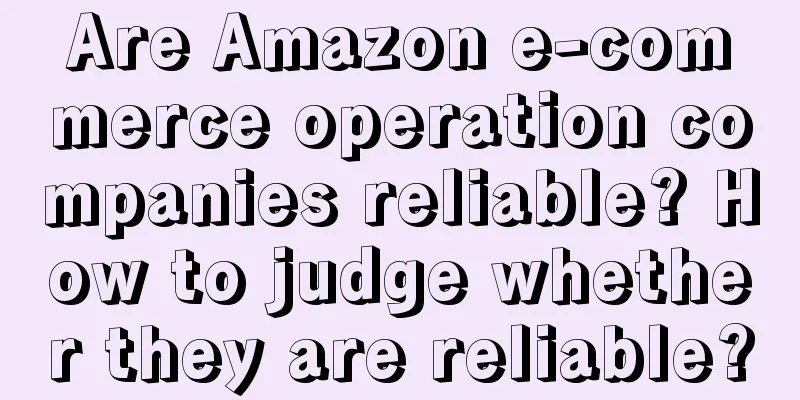Is it too expensive to attract new users? Recalling old users can help you grow more efficiently.

Traffic dividends are disappearing, and refined operations are king. For Internet products, the cost of acquiring new users is getting higher and higher. In contrast, recalling old users can effectively reduce marketing costs, increase conversion rates, and achieve growth goals. So, how do you judge whether your product is worth recalling? Why do users come back? Can you keep them? Today, we will explore the successful cases of user recall on other platforms, provide a MECE strategy and effect evaluation model that you can easily understand, and provide application suggestions for your product. (Another useful article) Without further ado, let's go straight to the main text. Enjoy: 1. Several issues that need to be determined before preparing for a recall1. What is user recall? What kind of objects are more worthy of recall?User recall refers to the process by which companies use various marketing and technical means to attract old users (who may have already left) who have previously purchased or used the company's products to buy or use them again in order to increase customer loyalty and repurchase rate. Compared with acquiring new users, recalling old users has greater advantages in terms of cost and effect. There are four types of churn: churn due to not logging in, churn due to not activating, churn due to new users, and churn due to long-term users. Usually, the second and third types of users have a greater chance of being recalled because they are reachable and have not yet deeply experienced the value of the product. 2. Why do old users churn? How to find the reason?Loss of old users is a problem faced by all companies. Understanding the reasons why target old users leave or stop using the product and retaining them is the key to the old user recall plan. Common reasons for user loss are classified as follows:
How to identify the most important reasons for user loss in our products? The mining methods are as follows:
3. How to evaluate the recall results?Direct results can be judged from push opening rate, click-through rate, and 24-hour visit rate; while long-term results can be judged from whether there is a core behavior (Aha moment/purchase order) and the retention rate of recalled users. After all, long-term results are the ultimate goal of recall. 2. Five successful user recall casesIn the context of refined operations, formulating a reasonable recall strategy for old users can increase user return rate and activity, while enhancing brand loyalty and user word-of-mouth effect. The following 5 old user recall cases of well-known products will take you to explore: 1. DropboxDropbox once implemented a program called “Welcome back” to attract old users who had previously lost. Dropbox offered these users free storage space through emails and promotional codes to encourage them to use Dropbox again. This strategy was a huge success, and the number of active users of Dropbox increased by 30%. 2. AirbnbAirbnb launched a campaign called “Never a Stranger” in 2016, inviting old users to return to Airbnb and invite others to become new users. Airbnb offered discounts to old users and allowed them to freely share the invitation link. The campaign led to 1 million new bookings and attracted more old users to return to Airbnb services. 3. SpotifySpotify sends emails to old users to invite them to resubscribe to its service and provides personalized playlists and song recommendations to attract them back. In addition, they have launched a feature called "Discover Weekly", which can provide personalized music recommendations based on users' listening habits to increase the retention rate of old users. 4. MeituanMeituan once launched a campaign called the "Returning Customer Program" to invite old users to return to Meituan's food delivery service. Meituan provided free coupons to old users and invited them to share links through WeChat to get more rewards. This move attracted a large number of lost users to return and increased the number of orders on the Meituan platform. 5. LinkedInLinkedIn has been trying to lure old users back by sending them emails inviting them to re-engage with its service, as well as providing personalized recommendations and content. In addition, they have launched a program called "Alumni" to help users connect with their alma mater, thereby generating more recall links. The successful old user recall cases listed above can be sorted into the following strategic categories: Can these cases be borrowed directly? Yes, but there is no rush. Recall is an important part of user lifecycle management and can be operated as a long-term project. If we design a more MECE (no duplication, no omission) solution, we can get better recall results (and convince the boss with a perfect project). *MECE, which stands for Mutually Exclusive Collectively Exhaustive, means "mutually independent and completely exhaustive". It means that for a major issue, it can be classified without overlap or omission, and it can effectively grasp the core of the problem and solve the problem. 3. MECE strategy for user recallCombining the lifecycle management model of the language learning platform Duolingo, establishing a user recall strategy can be divided into two steps:
Next, I will take you through the strategy step by step, so that you can learn it at a glance and use it as soon as you learn it: 1. Determine the recall targets and recall channelsTaking daily active products as an example, any user who is not active today can be included in the recall targets, which are the three types of users at the bottom of the figure below: weekly active users who may be lost, monthly active users who may be lost, and lost users. Why not simply classify them as "new users" + "old users"? In fact, the use of the lifecycle model not only makes the recall pool larger but also more refined, and the recall objects are stratified according to different levels of activity. Even if the user is not recalled in this layer, there is still a chance of being recalled if he or she loses to the next layer. For example, the shorter the churn time of users, the easier it is to recall them, so resources can be tilted towards these users. After confirming the recalled users, you can sort out the best channels to reach these users. The following table shows the classification of common channels and the estimated reach efficiency and channel costs. You can choose according to your business and product form. 2. Develop a tiered strategy to ensure no user is left behindIn the past, in the practice of user recall, we often chose an idea and invested all resources in it, hoping to have a single idea to attract customers (of course, the result was contrary to our expectations). In fact, from the perspective of structured thinking, we can consider it from the following three perspectives: basic recall, targeted recall, and personalized recommendation. Basic recall: refers to the recall of old users through simple and crude advertising. Specific methods include directly contacting old users through SMS, email, phone calls, etc. and providing promotions or coupons to attract them to use products or services again. In addition, more old users can be reached by posting advertisements on social media platforms. The advantages are that it is easy to operate, takes effect quickly, and can increase the return rate of old users through additional promotional activities. However, the disadvantages are that this method may be regarded as a nuisance by some old users, and may even have a negative impact on the brand image, and it requires continuous investment in advertising costs to maintain the effect. Targeted recall: more precise, it uses data analysis technology to classify and group old users, and conducts targeted recall based on the characteristics and needs of different groups. For example, by analyzing old users' purchase history, browsing history, search keywords and other data, old users can be divided into different interest groups. Then, based on these data, products and services that meet different interest groups are pushed in a targeted manner, thereby increasing the return rate of old users. The advantage is that it is more accurate and effective than basic recall, making the brand image less likely to be damaged. The disadvantage is that it requires more funds and technical manpower to carry out targeted marketing. Personalized recommendation: It is a strategy to recall old users by using big data and machine learning algorithms. It is a more in-depth evolution based on targeted recall, and with the help of user portraits and behavior data, accurate recommendations are made to each old user. In this way, even if there are different preferences and needs in the same interest group, personalized services can be provided to them, greatly improving the return rate. The advantage is that the effect is very obvious, making old users feel respected and valued, and can improve stickiness and loyalty. The disadvantage is that it requires a lot of data mining and algorithm development, with a high technical threshold, and also requires more capital and human resources. Here are some common user recall materials for reference:
Written at the endQuickly increase the recall rate of old users and say goodbye to the endless trouble of user loss! As market competition becomes increasingly fierce, the cost of acquiring new users for each business is getting higher and higher. At this time, recalling old users has become an important way for Internet products to grow rapidly. When implementing a plan to recall old users, we need to understand the needs of target users, choose appropriate recall strategies, and use data to evaluate and optimize the results. The above is all about the "Recall Strategy". Next time, I want to talk to you about small and beautiful products and how to generate membership revenue. Stay tuned! |
<<: In a large company, professionalism is your confidence
>>: 10 suggestions from friends after 618
Recommend
Mixue Ice City and Nongfu Spring enter the ice cup market, competing for the "ice cup +"
This article will explore the layout and strategie...
Is it easy to work as an Amazon Japanese operator? What does the job involve?
It is not an easy task to operate an online store,...
What should I do if my Amazon store is linked? What does it mean when a store is linked?
When selling on the Amazon platform, sellers need ...
How much does it cost to invest in Shopee? What are the costs of opening a Shopee store?
Now that many sellers are flocking to Shopee, of c...
How to attract traffic on Lazada? What do you need to know?
After Lazada's platform was established, the c...
Marketing budget is too small? Try this method
This article mainly introduces the concept of &quo...
Can Shopify sell globally? What sites does Shopify have?
In today's globalized business environment, ma...
From "brainwashing hits" to IPO: What did Mixue Bingcheng do right in its brand marketing?
From the viral spread of the "brainwashing di...
Everyone loves Anthropic
Anthropic, an emerging AI research company, is gra...
One year after TikTok Shop entered the US, where is content e-commerce heading?
As TikTok Shop develops steadily in the US, it is ...
Year-end summary: You need to be as cunning as a master
At the end of each year, many people in the workpl...
Category Adjustment of Alibaba International Station in October 2022
In order to optimize the product structure and enh...
Shuyi’s male sex marketing is comparable to Coco Tree!
Since the Coco Tree live broadcast room became pop...
Integration of brand and effect: How to achieve both popularity and sales volume, and gain both exposure and sales?
In brand marketing, brand-effect integration is ve...
Will I be detained if my foreign trade payment bank card is frozen? What is the reason for the freeze?
Merchants doing foreign trade business will have r...









